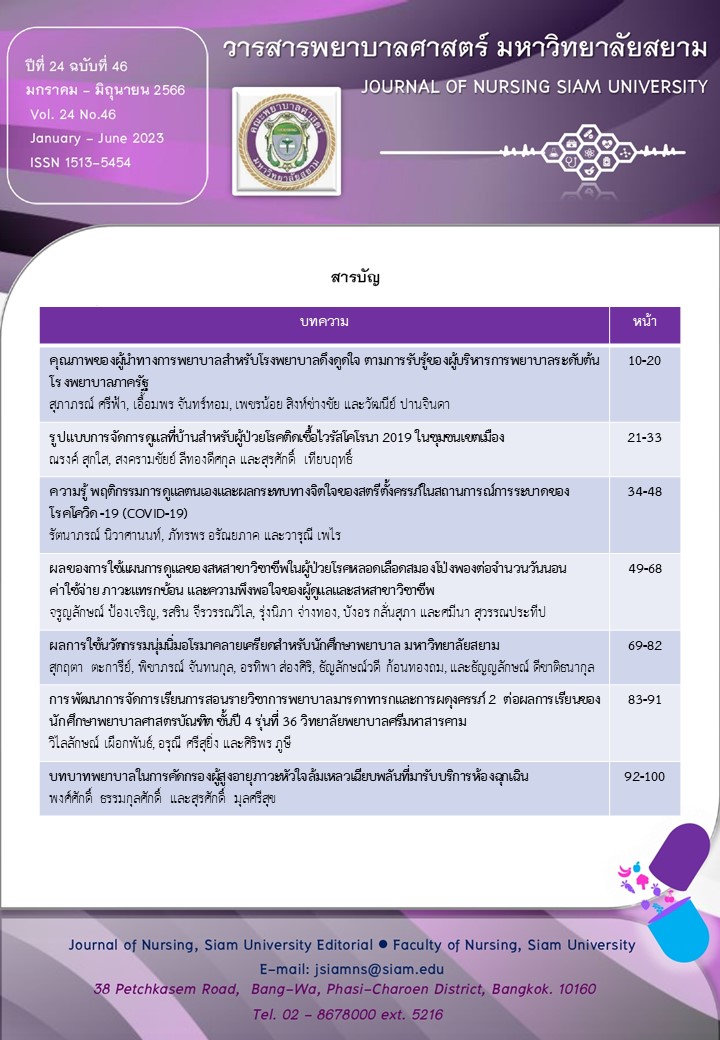ความรู้ พฤติกรรมการดูแลตนเองและผลกระทบทางจิตใจของสตรีตั้งครรภ์ในสถานการณ์ การระบาดของโรคโควิด -19 (COVID-19)
คำสำคัญ:
โรคโควิด-19, พฤติกรรมการดูแลตนเอง, สตรีตั้งครรภ์บทคัดย่อ
วัตถุประสงค์: เพื่อศึกษาระดับความรู้ พฤติกรรมการดูแลตนเอง และความสัมพันธ์ระหว่างความรู้ พฤติกรรมการดูแลตนเองกับผลกระทบทางจิตใจของสตรีตั้งครรภ์ในสถานการณ์การระบาดของโรคโควิด-19 (COVID-19)
วิธีการศึกษา: กลุ่มตัวอย่างสตรีตั้งครรภ์ที่มีอายุครรภ์อยู่ระหว่าง 12 ถึง 36 สัปดาห์ จำนวน 240 คน จากการสุ่มอย่างง่าย ฝากครรภ์กับหน่วยบริการในพื้นที่กรุงเทพมหานคร ระหว่างเดือนมกราคม – ธันวาคม พ.ศ. 2565 โดยใช้ แบบสอบถาม (Questionnaire) ในการเก็บรวบรวมข้อมูล จากนั้นวิเคราะห์ข้อมูลเชิงพรรณนาโดยใช้ความถี่ ค่าเฉลี่ย ร้อยละ ส่วนเบี่ยงเบนมาตรฐาน (SD) การทดสอบไคสแควร์ และการทดสอบสหสัมพันธ์แบบเพียร์สันในการวิเคราะห์ความสัมพันธ์ระหว่างตัวแปร โดยมีนัยสำคัญที่ระดับ .05 (P<.05)
ผลการศึกษา: สตรีตั้งครรภ์ส่วนใหญ่อายุระหว่าง 20-34 ปี (ร้อยละ 83.8) ส่วนใหญ่เป็นบุคลากรทางการแพทย์ (ร้อยละ31.7) และอายุครรภ์อยู่ในไตรมาส 3 (ร้อยละ 42.1) ส่วนใหญ่เข้ารับบริการฝากครรภ์ที่โรงพยาบาลเอกชน/คลินิกเอกชน (ร้อยละ58.3) สตรีตั้งครรภ์ร้อยละ 16.7 พบภาวะแทรกซ้อนขณะตั้งครรภ์ ร้อยละ 14.2 มีความวิตกกังวลต่อโรคโควิด-19 ในระดับสูง ร้อยละ 12.1 มีความเครียดในระดับสูง มีคะแนนความรู้เกี่ยวกับสถานการณ์โควิด-19 อยู่ในระดับสูง ( = 14.38 SD = 1.222) และมีพฤติกรรมการดูแลตนเองในการป้องกันการติดเชื้อเฉลี่ยอยู่ในระดับมาก ( = 1.69, SD = .46) พบว่า ระดับการศึกษา รายได้ ความเครียด และระดับความรู้เกี่ยวกับสถานการณ์การระบาดของโรคโควิด - 19
มีความสัมพันธ์กับความกังวล p < .05 (r = .132,.139, .150 และ.168 ตามลำดับ) และภาวะแทรกซ้อนขณะตั้งครรภ์ พฤติกรรมการดูแลตนเองมีความสัมพันธ์กับความความเครียด p < .05 (r = .221 และ-.137 ตามลำดับ) สตรีตั้งครรภ์มีความรู้และพฤติกรรมในการดูแลตนเองเกี่ยวกับการแพร่ระบาดของโรคโควิด-19 ที่ดี แต่พบว่าสตรีตั้งครรภ์จำนวนหนึ่งที่มีความเครียดและความวิตกกังวลในการดำเนินชีวิตประจำวัน
เอกสารอ้างอิง
กระทรวงสาธารณสุข.(2563). ร้อยละหญิงตั้งครรภ์ได้รับการฝากครรภ์ครั้งแรกก่อนหรือเท่ากับ 12 สัปดาห์ ปีงบประมาณ 2563. Health Data Center (HDC) .สืบค้นเมื่อ 6 มิถุนายน 2565,เข้าถึงได้จาก; https://hdcservice.moph.go.th/hdc/reports/report.php?source=pformated/format1.php&cat_ id=1ed90bc32310b503b7ca9b32af425ae5&id=1c1b8e24aff59258a806f122e264031e
กรมควบคุมโรค กระทรวงสาธารณสุข. (2565). แผนและมาตรการ การบริหารจัด การสถานการณ์โรคโควิด 19 สู่โรคประจำถิ่น.นนทบุรี: กรมควบคุมโรค กระทรวงสาธารณสุข
กรมสุขภาพจิต กระทรวงสาธารณสุข.(2563). คู่มือการปฏิบัติตามมาตรการผ่อนปรนกิจการและแนวทางการฟื้นฟูจิตใจในสถานการณ์การระบาดของโรคติดเชื้อไวรัสโคโรนา 2019 (COVID-19) (Combat 4th Wave of COVID-19 : C4). สืบค้นเมื่อ 20 สิงหาคม 2564,เข้าถึงได้จาก: https://www.dmh.go.th/covid19/pnews/view.asp?id=23
จรัส รัชกุล และคณะ. (2564). การประเมินการปฏิบัติตนของประชาชนในการป้องกันการแพร่ระบาดของโรคโควิด 19 ในช่วงครึ่งปีแรกของปี 2564. สถาบันวิจัยระบบสาธารณสุข, 2564-10. Available at:https://kb.hsri.or.th/ dspace/handle/11228/5487
ณัฎฐวรรณ คําแสน. (2563). ความรู้ ทัศนคติ และพฤติกรรมในการป้องกันตนเองจากการติดเชื้อไวรัสโควิด-19 ของประชาชนในเขตอําเภออู่ทอง จังหวัดสุพรรณบุรี . วารสารวิทยาลัยพยาบาลพระจอมเกล้า จังหวัดเพชรบุรี, 4(1),33-47.
ตรีรัก กินวงษ์. (2563). พฤติกรรมการจัดการหน้ากากอนามัยของประชากรในกรุงเทพมหานคร .คณะบริหารการพัฒนาสิ่งแวดล้อม สถาบันบัณฑิตพัฒนบริหารศาสตร์.
นิภา สุทธิพันธ์, ทิตยาวดี อินทรางกูร.(2565). ความวิตกกังวล ความเครียด และการป้องกันตนเองของประชาชนในหมู่บ้านที่ถูกสั่งปิดจากการระบาดของไวรัสโคโรนา 2019 ในเขตอำเภอเมืองบุรีรัมย์. วารสารทางการแพทย์โรงพยาบาลศรีสะเกษ สุรินทร์ บุรีรัมย์,37(1),31-39
เบญญาภา ธิติมาพงษ์, ศศิธร พุมดวง, จัณทร์ปภัสร์ เครือแก้ว, โสเพ็ญ ชูนวล และวิไลพร สมานกสิกรณ์. (2563). การพยาบาลมารดา ทารกและการผดุงครรภ์ 1 (เล่ม 1). คณะพยาบาลศาสตร์ มหาวิทยาลัยสงขลานครินทร์. สืบค้นเมื่อ 21 มิถุนายน 2566,เข้าถึงได้จาก; https://www.nur.psu.ac.th/nur/file_web/ตำราการพยาบาลมารดาทารกและการผดุงครรภ์1เล่ม1.pdf
ปิยะนันท์ ลิมเรืองรอง. บรรณาธิการ. (2560). การพยาบาลสตรีตั้งครรภ์ Prenatal Nursing Care.กรุงเทพฯ: โครงการตำราคณะพยาบาลศาสตร์ มหาวิทยาลัยมหิดล.
รัฐบาลไทย. ข่าวนายกรัฐมนตรี 20/05/2565. เข้าถึงได้จาก: https://www.thaigov.go.th/news/contents/details/54801.
ราชวิทยาลัยสูตินรีแพทย์แห่งประเทศไทย. (2564). แนวทางเวชปฏิบัติของราชวิทยาลัยสูตินรีแพทย์แห่งประเทศไทยเรื่องการดูแลรักษาสตรีตั้งครรภ์ที่ติดโรคโควิด-19 RTCOG Clinical Practice Guideline Management of Covid-19 Infection in Pregnancy. ฉบับปรับปรุง Version 6 วันที่ 20 สิงหาคม2564. เข้าถึงได้จาก; https://www.thainapci.org/2021/wp-content/uploads/2021/05/CPG-Covid-Preg-V5-21May21-edit-24May21.pdf
ศริณธร มังคะมณี,ศิริพร ชุดเจือจีน. (2553). การศึกษาภาวะสุขภาพจิตของหญิงตั้งครรภ์ที่รับบริการฝากครรภ์ ณ โรงพยาบาลเจ้าพระยายมราช จังหวัดสุพรรณบุรี . วารสารการพยาบาลและการศึกษา, 3(1): 29--0.
อรทัย แซ่ตั้ง, จรรยาแก้วใจบุญ และ ฐิติพร เรือนกุล. (2564). ความเครียดและปัจจัยที่เกี่ยวข้องต่อความเครียดของหญิงตั้งครรภ์อายุมาก. วารสารวิจัยการพยาบาลและสุขภาพ, .22(3),71-83
อังสินี กันสุขเจริญ และวรวรรณ เจริญสุข. (2563). การจัดบริการฝากครรภ์ ภายใต้สถานการณ์การแพร่ระบาดของโรคโควิด-19 โรงพยาบาลหัวหิน. วารสารหัวหินสุขใจไกลกังวล, 5(1), 1-11.
Azlan, A. A., Hamzah, M. R., Sern, T. J., Ayub, S. H., & Mohamad, E. (2020). Public Knowledge ,Attitudes and Practices Towards COVID-19: A cross-sectional study in Malaysia. PLOS ONE, 15(5), e0233668. doi:10.1371/journal.pone.0233668.
Bender, W. R., Srinivas, S., Coutifaris, P., Acker, A., & Hirshberg, A. (2020). The Psychological Experience of Obstetric Patients and Health Care Workers after Implementation of Universal SARS-CoV-2 Testing. American Journal of Perinatology,37(12),1271-1279. doi: 10.1055/s-0040-1715505
Cohen, J. (1988). Statistical Power Analysis for the Behavioral Sciences (2nd ed.). Hillsdale, NJ: Lawrence Erlbaum Associates.
Chen,N., Zhou,M., Dong,X., Qu,J., Gong,F., Han,Y., Zhang, L. (2020). Epidemiological and clinical characteristics of 99 cases of 2019 novel coronavirus pneumonia in Wuhan, China: a descriptive study. Lancet, 395(10223),507-513.
Dashraath P, Lin, J., Xian, M., Min, L., Sarah,L., Biswas,A,. Lin, L. (2020). Coronavirus Disease 2019 (COVID-19)pandemic and pregnancy. Am J Obstet Gynecol. 23. pii:S0002-9378(20)30343-4.doi:10.1016/j.ajog2020.03.021
Gravena, A.A., Sass, A., Marcon ,S. S., Pelloso, S.M. Outcomes in Late-age Pregnancies. Rev Esc Enferm USP, 46(1)1, 15-21.
Ginwong, T. (2020). Disposable Mask Management Behavior of Bangkok’s people. (independent Study ).Bangkok: National Institute of Development Administration.
Lambelet, V., Ceulemans, M., Nordeng, H., Favre, G., Horsch, A., Stojanov, M., Pomar, L. (2021). Impact of the COVID-19 Pandemic on Swiss Pregnant and Breastfeeding Women a Cross- Sectional Study Covering the First Pandemic Wave. Swiss Medical Weekly, 2021(151),w30009.doi: 10.4414/smw.2021.w30009
Mills, M., Rindfuss, R., McDonald, P., & Te-Velde, E. (2011). Why do people postpone parenthood? Reasons and social policy incentives. Human Reproduction Update, 17(6):848-60.
World Health Organization Thailand. 2022.COVID-19 Update 239. World Health Organization Thailand.Available at:https://cdn.who.int/media/docs/defaultsource/searo/thailand/2022_06_08_tha-sitrep-239-covid-19_th.pdf?sfvrsn=2d393008_1(accessed December 31 ,2022).
Orley, J., Kuyken, W., editor. (1994). Quality of life Assessment: international perspectives. New York: Springer-Verlag.
World Health Organization. (2018). Laboratory testing for Middle East respiratory syndrome coronavirus: interim guidance (revised). Geneva: http://www.who.int/csr/disease/coronavirus_infections/mers-laboratory-testing/en/, (accessed 14 June 2022).
Zaigham, M., & Andersson, O. (2020). Maternal and perinatal outcomes with COVID-19: a systematic review of 108 pregnancies. Acta Obstet Gynecol Scand, 99, 823-829. doi: 10.1111/aogs.13
ดาวน์โหลด
เผยแพร่แล้ว
รูปแบบการอ้างอิง
ฉบับ
ประเภทบทความ
สัญญาอนุญาต
ลิขสิทธิ์ (c) 2023 วารสารพยาบาลศาสตร์ มหาวิทยาลัยสยาม

อนุญาตภายใต้เงื่อนไข Creative Commons Attribution-NonCommercial-NoDerivatives 4.0 International License.
เนื้อหาและข้อมูลที่เผยแพร่ในวารสารพยาบาลศาสตร์ มหาวิทยาลัยสยามถือเป็นข้อคิดเห็นและความรับผิดชอบของผู้นิพนธ์บทความโดยตรง
บทความ เนื้อหา ข้อมูล รูปภาพ ฯลฯ ที่ได้รับการเผยแพร่ในวารสารพยาบาลศาสตร์ มหาวิทยาลัยสยาม ถือเป็นลิขสิทธิ์ของวารสารพยาบาลศาสตร์ มหาวิทยาลัยสยาม หากบุคคลหรือหน่วยงานใดต้องการนำทั้งหมดหรือส่วนหนึ่งส่วนใดไปเผยแพร่หรือเพื่อกระทำการใด ๆ จะต้องอ้างอิงวารสารพยาบาลศาสตร์ มหาวิทยาลัยสยามทุกครั้ง



